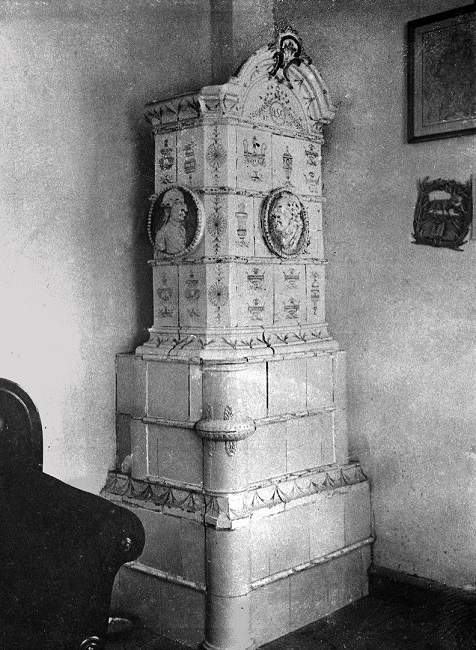Workshop: unknown
Inscriptions: in the pediment, a painted monogram “GSG” in a medallion and the annual date “1798”.
A pottery product composed of two types of tiles; stamping from matrices, manual processing, glazing, painting with cobalt, manganese and copper compounds on raw tin glaze and with antimony compounds on fired glaze, multiple firing; putting the stove up with the stove fitting method twice.
Dimensions: The overall furnace is not unknown. Cornice tiles (18th century): height 15.5 cm, width 22.2 cm, depth 9.8 cm; corner tiles (19th century): height 22 cm, diameter 21.5 cm, depth 6 cm. Approximate dimensions of the tond: diameter 28 cm, thickness 3.6 cm.
Provenance: Prussia, Piaski Sztumskie (German: Sandhuben), commune Dzierzgoń
A tiled stove, three-story, rectangular in shape. Two lower, nineteenth-century floors containing the hearth chest, bricked to the side walls of the room that the stove heated. A cuboid-shaped extension made of 18th-century tiles decorated with painted motifs of rosettes in oval, hanging medallions, urn-shaped vases with garlands and two portrait medallions. The stove is crowned with a baroque pediment composed of two fleshy C-profiles, turned at their backs and fastened with a conventional clamp. Above them, a form of a rooster’s comb, with jagged turbinates, on the side of which rolled, lanceolate leaves protrude. In the pediment there is a monogram in a medallion, and below the date. Cornice tiles, top, middle and corner, with a roller-concave-roller profile with steps, between washers. There is a painted decoration made of two hanging scarves. Characteristic elements in the decoration of scarves are slightly cupped, narrow folds with an internal ladder division and, in the greatest depression, a line marking of dense, almost vertical and horizontal folds. White, corner tiles shaped like segments of semi-column shafts. The lower ones with a base profile, the upper ones resembling heads due to the relief motifs of lanceolate leaves placed under the quarter-roller cornice lacing, also decorated with a carefully imprinted leaf motif.
From the correspondence of April 24, 1909 between Conrad Steinbrecht and Gustav Sperling, an inhabitant of Piaski Sztumskie, it appears that he offered for purchase stove tiles dating back to 1898. After their purchase in 1910, the stove was erected from 95 tiles and displayed in a storage room on High Castle.
To this day, only fragments of the filling tile (inv. MZM / K / d / 274) with a painted lampshade motif, the central fragment of the pediment (inv. MZM / K / 258) and a few cornice tiles (inv. MZM / K) have survived from the entire body of the furnace. / 495−499) decorated with the motif of a suspended scarf, which came from the first furnace from the end of the 18th century. In addition, the nineteenth-century, semicircular, white corner tiles have survived from the lower part: smooth, with a plinth and one decorated with relief leaf motifs (inv. MZM / K / 858 / 1−2). Two interesting portrait tondas have not survived. A similar tondo, but not identical to that of the furnace in Piaski Sztumskie, is currently in the collection of the Museum in Kwidzyn (inv. MK / S / 141). It was purchased in 1925 for the collection of the former Regional Museum (German: Heimatmuseum) in Kwidzyn (inv. HMM, W / Pr. 71).
(compiled by Dr. B. Pospieszna)

